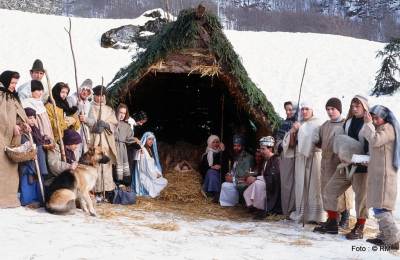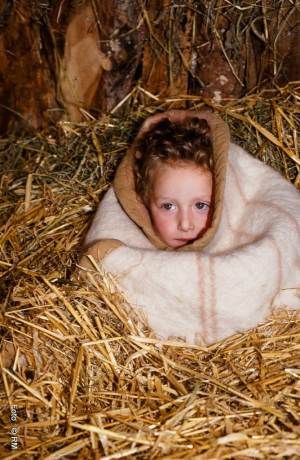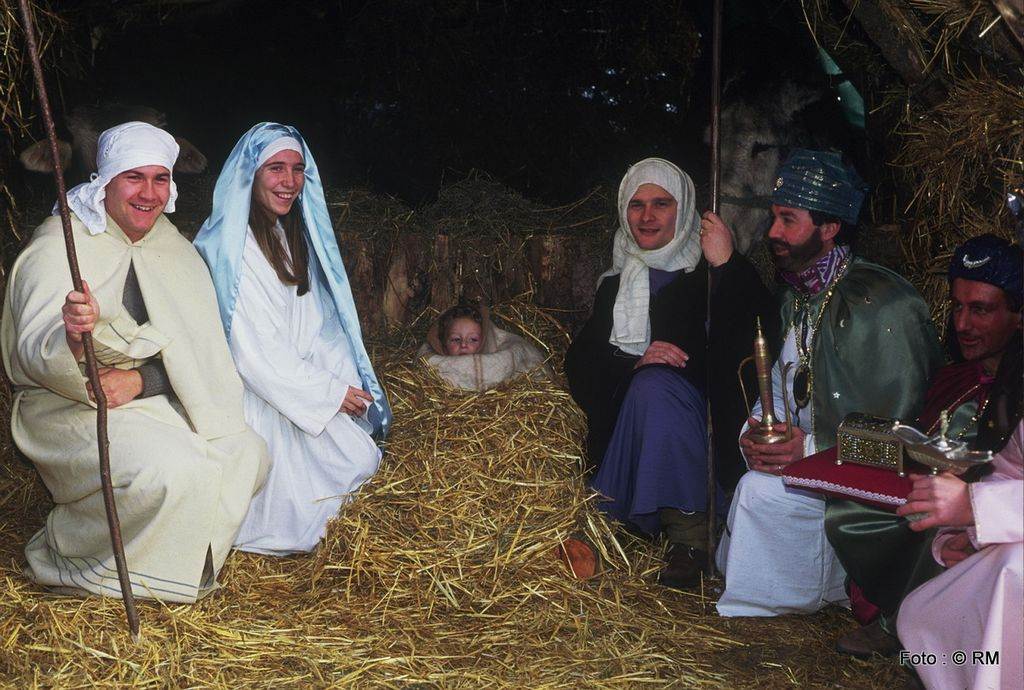by Cinzia Faldrini
 The protagonists of the 1st living nativity scene in 1991.
The protagonists of the 1st living nativity scene in 1991.
The living nativity scene began in response to a competition for nativity scenes, called by the parish of Lanzada in 1991.
This is why it was called the living nativity scene of Vetto, and only later, when it was no longer linked to the nativity competition and was open to people from other districts, did it become the living nativity scene of the parish of Lanzada.
The idea came to Luigi Bontempi, an inhabitant of Vetto, during a meeting with others from the district to work on the idea of creating the district nativity scene.
He suggested taking part in the competition not with a static scene, but with a living nativity scene.
They notified the parish priest, don Renato Lanzetti, of their decision, who at first had his doubts that a work of this kind could be prepared in such a short time.
He had to change his mind though as the inhabitants of Vetto would not be convinced and successfully put their heads down to work.
They immediately contacted the inhabitants of Vetto and over twenty poeople answered and collaborated enthusiastically.
 Antonio, the first Baby Jesus!
Antonio, the first Baby Jesus!
The first living nativity scene only had the stable made with a wooden frame draped in curtains.
Inside was the crib.
The first Madonna was Elisabetta Masa, the first Joseph, Mario Masa, and the baby Jesus was played by Antonio Bergomi (it should have been another child who unfortunately fell ill with chickenpox and had to be replaced).
The first performance also saw the three wise kings played by Mario Bergomi, Mario Gaggi and Ivano Guerra.
The donkey, called Pino, had been lent by a certain “Ricciolino” from Torre di Santa Maria.
He had intended to kill the animal, but as a favour to the inhabitants of Vetto, he had kept it alive.
The strange fact was that he continued to "pardon" the animal for another eight years to allow it to play its part as "actor" in the nativity scene of Lanzada.
The first comments recorded were certainly far more rudimental than the current recordings.
They used a recorder and they went into a silent room: they played background music from another recorder and recorded the spoken part on the other.
If anyone came into the room right in the middle and made a noise, they would have to start all over again.
And this went on for many years.
 The stable with the Three Kings.
The stable with the Three Kings.
Going back to the first performance, I wanted to hear the opinions of the first visitors.
I noticed people still remembered the scene of the husband and wife, with Mary on the donkey and Joseph, who arrived from behind the dunes of the natural amphitheatre where the performance was held in Vetto, as they went to the stable where the child was born, followed by the adoration.
Very simple scenes, without any great technology to accompany them, but certainly some of the most impressive and most moving.
That year, the living nativity scene did not win first prize.
However, I quote a comment taken from the parish newsletter, number 48 of April 1992 which reads:
A very special mention goes to the group from Vetto who created a living nativity scene for the first time.
The jury, consisting of a few tourists and Mgr.
Lanfranconi, highlighted the originality of the idea, the strong commitment involving many people, the successful performance, the good choice of location and the care taken over the costumes and all the numerous details, and that it had attracted a large, satisfied public.